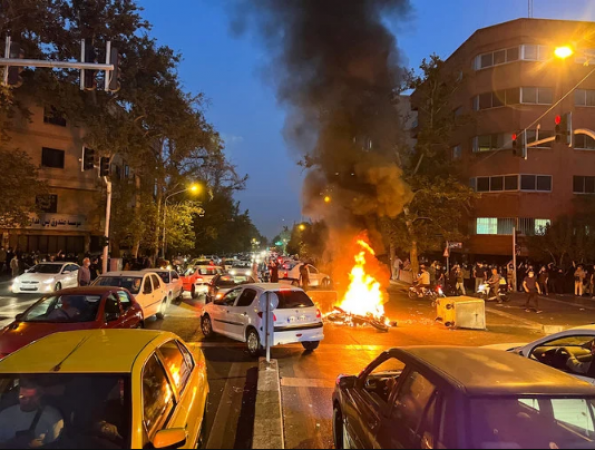
Tehran: Pakistan: On Saturday, communication was cut off in Zahedan, a city in southeast Iran, following the death of a senior commander of the Islamic Revolutionary Guard Corps in clashes.The alleged rape of a 15-year-old Baloch girl by a local military commander sparked protests in the province's capital of Sistan and Balochistan, which borders Pakistan, on Friday.During the clash with protesters, Ali Mousavi, the IRGC's Sistan and Balochistan intelligence chief, was shot. According to the IRGC-affiliated Tasnim News Agency, Mousavi was declared dead at a hospital.
Also Read: Main Imam of Al-Azhar to Attend Bahrain Forum with Pope Francis
The militant Jaish Al-Adl group, which says it is fighting for Sistan and Balochistan's independence and greater rights for the Baloch people, the province's primary ethnic group, claimed responsibility for Mousavi's murder.
In the midst of intense gunfire, footage from Zahedan showed people carrying dead and injured protesters. The provincial government reported that 19 people had died in the fighting. At least 36 people were reported dead, and numerous others were injured, according to the local news agency Haal-e Vash.
An alternative account of the violence was published by Iran's state-run IRNA news agency. In Zahedan, an armed separatist attack left 19 people dead, including four IRGC members, according to the report.
The provincial governor, Hossein Modaresi, was quoted by IRNA as saying that 19 people had died. According to the source, the clashes also injured 32 Guard members, including volunteer Basiji forces.
IRNA identified the deceased as Revolutionary Guard colonel Hamidreza Hashemi, Guard member Mohammad Amin Azarshokr, Basiji Mohamad Amin Arefi, and Basiji Saeed Borhan Rigi on Saturday.
Also Read: As protests spread internationally Tehran regime faces international isolation
The anti-government protests that started in mid-September were significantly escalated by the death of Mahsa Amini, 22, while she was being detained by the Iranian morality police for donning her headscarf "inappropriately," which led to the death of the provincial IRGC intelligence chief.
Over the past two weeks, tens of thousands of Iranians have protested Mahsa Amini's passing in the streets. The protesters used their outrage at the treatment of women and other forms of repression in the Islamic Republic to express themselves. The calls for the overthrow of the clerical establishment that has ruled Iran since its Islamic revolution in 1979 became increasingly louder during the widespread protests.
Kurdish opposition movements in the northwest that operate along the border with neighbouring Iraq have joined the protests as supporters. The protests began in Kurdish regions, and Amini was an Iranian Kurd.
At least 41 protesters and police have died since the demonstrations started on September 17, according to Iranian state television. At least 14 people have died, according to official government statements compiled by the Associated Press, and more than 1,500 protesters have been detained.
On Friday, Iran announced that it had detained nine foreigners who were connected to the protests, which the government has attributed to hostile foreign actors without any supporting documentation.
Also Read: Churches fight to keep a legal loophole on sexual abuse reporting.a
It has been challenging to estimate the size of the demonstrations, especially those outside of Tehran. The demonstrations have only occasionally been covered by Iranian media.
On Saturday, students protested the ongoing crackdown in Tehran and other Iranian cities.
Internationally dispersed Iranians and those who support them gathered in cities all over the world.
They shouted "Woman, life, freedom" and "Death to the dictator" in the streets of Saqqez, Amini's hometown in the Kurdistan region.
As students protested in Enghelab (Revolution) Square near Tehran University in the city centre to demand the release of detained students, riot police gathered at key intersections throughout the capital.
Some of the protesters who were chanting slogans were arrested after police and protesters fought.
Video footage from other cities, including the second city Mashhad and Karaj, west of the capital, was also shared by the Oslo-based Iran Human Rights group.
Women were seen taking off their headscarves and chanting with the protesters.
According to the Iranians for Justice and Human Rights organisation, support demonstrations have been called for in 159 cities around the world, from Auckland to New York and Seoul to Zurich. Approximately 1,000 people attended a rally in Rome where six women cut their hair in support.
Meanwhile, according to the foreign-based opposition Telegram channel Kaleme, Iranian opposition leader Mir Hossein Mousavi reminded Iran's armed forces of their responsibility to protect human rights and lives.
Before being suppressed by the government, Mousavi's Green Movement challenged Iran's contested 2009 presidential election by inciting unrest on a scale unseen since its 1979 Islamic Revolution.
The ability that was given to you, he continued, "clearly is for defending people, not suppressing people, defending the oppressed, not serving powerful people and oppressors."